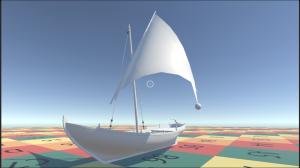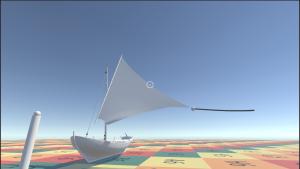09-11-2022, 02:55 PM
Essentially what I'm trying to do here:
I have an Obi cloth object (the sail)
The sail has two particle groups, one connected to the mast spar via a static particle attachment point. The second connects to the sphere via a dynamic particle attachment.
The idea is to be able to attach a rope to the sphere as well, and manipulate in a variety of ways. However, when I attach an obi rope to the sphere in the same method -- it seems to be radically more affected by the ambient force in the scene -- enough to stretch the sail in its effort to fly away. Increasing the mass of the rope (or the sphere) has minimal effect.
Can you give me some feedback as to what is going on here? My intent/expectation was for the rope to hang from the sphere in a similar manner to the sphere alone.
I've included two images. The first is the sail + sphere without the rope. The second shows the same scene after activating the rope.
In an effort to minimize variables, collisions have been disabled for all obi colliders. Both the rope and sail use the same solver.


I have an Obi cloth object (the sail)
The sail has two particle groups, one connected to the mast spar via a static particle attachment point. The second connects to the sphere via a dynamic particle attachment.
The idea is to be able to attach a rope to the sphere as well, and manipulate in a variety of ways. However, when I attach an obi rope to the sphere in the same method -- it seems to be radically more affected by the ambient force in the scene -- enough to stretch the sail in its effort to fly away. Increasing the mass of the rope (or the sphere) has minimal effect.
Can you give me some feedback as to what is going on here? My intent/expectation was for the rope to hang from the sphere in a similar manner to the sphere alone.
I've included two images. The first is the sail + sphere without the rope. The second shows the same scene after activating the rope.
In an effort to minimize variables, collisions have been disabled for all obi colliders. Both the rope and sail use the same solver.




